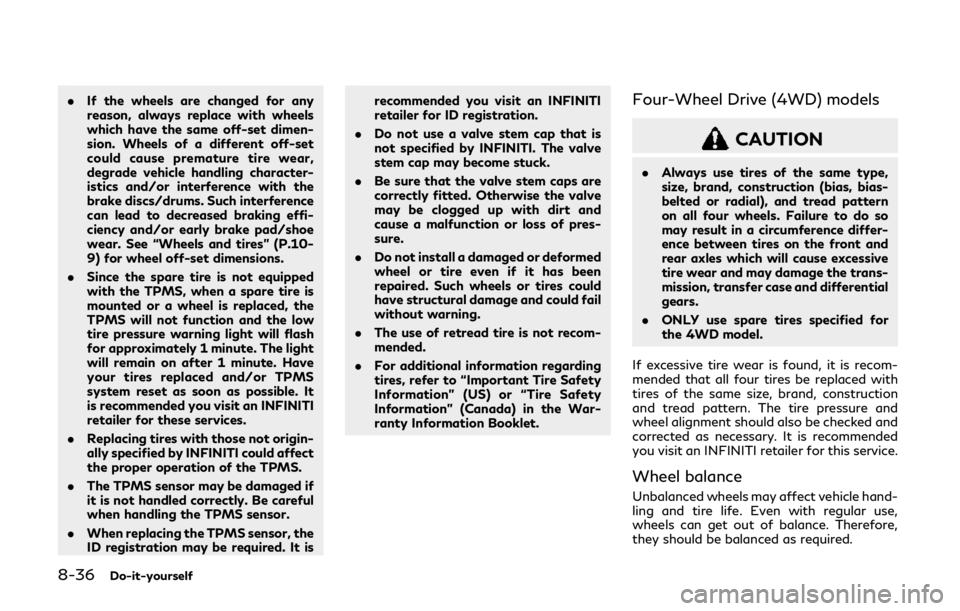4WD INFINITI QX80 2019 Owner's Guide
[x] Cancel search | Manufacturer: INFINITI, Model Year: 2019, Model line: QX80, Model: INFINITI QX80 2019Pages: 524, PDF Size: 2.45 MB
Page 454 of 524

8-36Do-it-yourself
.If the wheels are changed for any
reason, always replace with wheels
which have the same off-set dimen-
sion. Wheels of a different off-set
could cause premature tire wear,
degrade vehicle handling character-
istics and/or interference with the
brake discs/drums. Such interference
can lead to decreased braking effi-
ciency and/or early brake pad/shoe
wear. See “Wheels and tires” (P.10-
9) for wheel off-set dimensions.
. Since the spare tire is not equipped
with the TPMS, when a spare tire is
mounted or a wheel is replaced, the
TPMS will not function and the low
tire pressure warning light will flash
for approximately 1 minute. The light
will remain on after 1 minute. Have
your tires replaced and/or TPMS
system reset as soon as possible. It
is recommended you visit an INFINITI
retailer for these services.
. Replacing tires with those not origin-
ally specified by INFINITI could affect
the proper operation of the TPMS.
. The TPMS sensor may be damaged if
it is not handled correctly. Be careful
when handling the TPMS sensor.
. When replacing the TPMS sensor, the
ID registration may be required. It is recommended you visit an INFINITI
retailer for ID registration.
. Do not use a valve stem cap that is
not specified by INFINITI. The valve
stem cap may become stuck.
. Be sure that the valve stem caps are
correctly fitted. Otherwise the valve
may be clogged up with dirt and
cause a malfunction or loss of pres-
sure.
. Do not install a damaged or deformed
wheel or tire even if it has been
repaired. Such wheels or tires could
have structural damage and could fail
without warning.
. The use of retread tire is not recom-
mended.
. For additional information regarding
tires, refer to “Important Tire Safety
Information” (US) or “Tire Safety
Information” (Canada) in the War-
ranty Information Booklet.Four-Wheel Drive (4WD) models
CAUTION
.Always use tires of the same type,
size, brand, construction (bias, bias-
belted or radial), and tread pattern
on all four wheels. Failure to do so
may result in a circumference differ-
ence between tires on the front and
rear axles which will cause excessive
tire wear and may damage the trans-
mission, transfer case and differential
gears.
. ONLY use spare tires specified for
the 4WD model.
If excessive tire wear is found, it is recom-
mended that all four tires be replaced with
tires of the same size, brand, construction
and tread pattern. The tire pressure and
wheel alignment should also be checked and
corrected as necessary. It is recommended
you visit an INFINITI retailer for this service.
Wheel balance
Unbalanced wheels may affect vehicle hand-
ling and tire life. Even with regular use,
wheels can get out of balance. Therefore,
they should be balanced as required.
Page 462 of 524

9-6Maintenance and schedules
Brake pads and rotors:
Check for wear, deterioration and fluid
leaks. Replace any deteriorated or damaged
parts immediately.
Exhaust system:
Visually inspect the exhaust pipes, muffler
and hangers for leaks, cracks, deterioration,
and damage. Tighten connections or replace
parts as necessary.
In-cabin microfilter:
Replace at specified intervals. When driving
for prolonged periods in dusty conditions,
replace the filter more frequently.
Propeller shaft(s):
Check for damage, looseness, and grease
leakage. (4WD/RWD)
Steering gear and linkage, axle and suspen-
sion parts, drive shaft boots:
Check for damage, looseness, and leakage
of oil or grease. Under severe driving condi-
tions, inspect more frequently.
Tire rotation:
Tires should be rotated every 5,000 miles
(8,000 km) according to the instructions
under “Explanation of scheduled mainte-
nance items” (P.9-5). When rotating tires,
check for damage and uneven wear. Replace
if necessary.
Transmission fluid/oil, differential oil andtransfer case oil:
Visually inspect for signs of leakage at
specified intervals.
To help ensure smooth, safe and economical
driving, INFINITI provides two maintenance
schedules that may be used, depending upon
the conditions in which you usually drive.
These schedules contain both distance and
time intervals, up to 120,000 miles
(192,000 km)/144 months. For most peo-
ple, the odometer reading will indicate when
service is needed. However, if you drive very
little, your vehicle should be serviced at the
regular time intervals shown in the schedule.
After 120,000 miles (192,000 km)/144
months, continue maintenance at the same
mileage/time intervals.
ADDITIONAL MAINTENANCE
ITEMS FOR SEVERE OPERATING
CONDITIONS
Additional maintenance items for severe
operating conditions;
should be performed
on vehicles that are driven under especially
demanding conditions. Additional mainte-
nance items should be performed if you
primarily operate your vehicle under the
following conditions:
. Repeated short trips of less than 5 miles
(8 km).
. Repeated short trips of less than 10 miles
(16 km) with outside temperatures re-
maining below freezing.
MAINTENANCE SCHEDULES
Page 466 of 524

9-10Maintenance and schedules
CHASSIS AND BODY MAINTENANCE
Abbreviations: I = Inspect and correct or replace as necessary, R = Replace, L = Lubricate
MAINTENANCE OP-
ERATION
Perform at of miles,
kilometers or months,
whichever comes first.Miles × 1,000
(km × 1,000) Months MAINTENANCE INTERVAL
5
(8) 6 10
(16) 12 15
(24) 18 20
(32) 24 25
(40) 30 30
(48) 36 35
(56) 42 40
(64) 48 45
(72) 54 50
(80) 60 55
(88) 66 60
(96) 72
Brake lines and cables I I I I I I
Brake pads and rotors$ II I I I I
Brake fluid$ RR R
Automatic transmission
fluid See NOTE (1)
Transfer fluid and dif-
ferential gear oil See NOTE (2)
II I I I I
Steering gear and link-
age, axle and suspension
parts$ II I
Tire rotation See NOTE (3)
Propeller shaft and drive
shaft boots (4WD mod-
els)$ II I I I I
Propeller shaft grease
(4WD models) LL L L L L
Exhaust system$ II I
In-cabin microfilter RR R R
Intelligent Key battery RR R R
Page 467 of 524

MAINTENANCE OP-
ERATION
Perform at of miles, kilo-
meters or months,
whichever comes first.Miles × 1,000
(km × 1,000) Months MAINTENANCE INTERVAL
65
(104) 78 70
(112) 84 75
(120) 90 80
(128) 96 85
(136) 102 90
(144) 108 95
(152) 114 100
(160) 120 105
(168) 126 110
(176) 132 115
(184) 138 120
(192) 144
Brake lines & cables IIII I I
Brake pads & rotors$ IIII I I
Brake fluid$ RR R
Automatic transmission
fluid See NOTE (1)
Transfer fluid & differen-
tial gear oil See NOTE (2)
IIII I I
Steering gear & linkage,
axle & suspension parts$ II I
Tire rotation See NOTE (3)
Propeller shaft & drive
shaft boots (4WD mod-
els)$ IIII I I
Propeller shaft grease
(4WD models) LLLL L L
Exhaust system$ II I
In-cabin microfilter RRR R
Intelligent Key battery RRR R
Maintenance and schedules9-11
Page 469 of 524

The maintenance intervals shown on the
preceding pages are for normal operating
conditions. If the vehicle is mainly operated
under severe driving conditions as shown
below, more frequent maintenance must be
performed on the following items as shown
in the table.
Severe driving conditions
.Repeated short trips of less than 5 miles
(8 km).
. Repeated short trips of less than 10 miles
(16 km) with outside temperatures re-
maining below freezing.
. Operating in hot weather in stop-and-go
“rush hour” traffic.
. Extensive idling and/or low speed driving
for long distances, such as police, taxi or
door-to-door delivery use.
. Driving in dusty conditions.
. Driving on rough, muddy, or salt spread
roads.
. Towing a trailer, using a camper or car-
top carrier.
Maintenance operation: Inspect = Inspect
and correct or replace as necessary.Maintenance item Maintenance operation Maintenance interval
Brake fluid ReplaceEvery 10,000 miles (16,000 km) or 12
months
Brake pads & rotors InspectEvery 5,000 miles (8,000 km) or 6
months
Steering gear & linkage, axle &
suspension parts Inspect
Every 5,000 miles (8,000 km) or 6
months
Propeller shaft & drive shaft
boots (4WD models) Inspect
Every 5,000 miles (8,000 km) or 6
months
Exhaust system InspectEvery 5,000 miles (8,000 km) or 6
months
Maintenance and schedules9-13
MAINTENANCE UNDER SEVERE
DRIVING CONDITIONS
Page 494 of 524

10-22Technical and consumer information
TOWING LOAD/SPECIFICATION CHARTUnit: lb (kg)
US Canada
Two-Wheel Drive (2WD) model Four-Wheel Drive
(4WD) model Four-Wheel Drive
(4WD) model
MAXIMUM TOWING CAPA-
CITY*1, *2 8,500 (3,856)
8,500 (3,856)
MAXIMUM TONGUE LOAD 850 (385)850 (385)
GROSS COMBINED WEIGHT
RATING 14,300 (6,486) 14,480 (6,568) 14,480 (6,568)
1: The towing capacity values are calculated assuming a base vehicle with driver and any
options required to achieve the rating. Additional passengers, cargo and/or optional
equipment will add weight to the vehicle and reduce your vehicle’s maximum towing
capacity.
2: Use of a weight-distributing hitch system is recommended when towing over 5,000 lb (2,267 kg).
TOWING SAFETY
Trailer hitch
Your vehicle is equipped with a trailer tow
package. The trailer tow package includes a
receiver-type frame mounted hitch. This
hitch is rated for the maximum towing
capacity of this vehicle when the proper
towing equipment is used. Choose a proper
ball mount and hitch ball that is rated for the
trailer to be towed. Genuine INFINITI ball
mounts and hitch balls are available from an
INFINITI retailer.
Page 499 of 524

down condition; check for improper
tongue load, overload, worn suspension
or other possible causes of either condi-
tion.
. Always secure items in the trailer to
prevent load shift while driving.
. Keep the cargo load as low as possible in
the trailer to keep the trailer center of
gravity low.
. Load the trailer so approximately 60% of
the trailer load is in the front half and
40% is in the back half. Also make sure
the load is balanced side to side.
. Check your hitch, trailer tire pressure,
vehicle tire pressure, trailer light opera-
tion, and trailer wheel lug nuts every time
you attach a trailer to the vehicle.
. Be certain your rearview mirrors conform
to all federal, state or local regulations. If
not, install any mirrors required for
towing before driving the vehicle.
. Determine the overall height of the
vehicle and trailer so the required clear-
ance is known.
Trailer towing tips
In order to gain skill and an understanding of
the vehicle’s behavior, you should practice
turning, stopping and backing up in an area
which is free from traffic. Steering stability,
and braking performance will be somewhat different than under normal driving condi-
tions.
.
Always secure items in the trailer to
prevent load shift while driving.
. Lock the trailer hitch coupler with a pin or
lock to prevent the coupler from inad-
vertently becoming unlatched.
. Avoid abrupt starts, acceleration or
stops.
. Avoid sharp turns or lane changes.
. Always drive your vehicle at a moderate
speed. Some states or provinces have
specific speed limits for vehicles that are
towing trailers. Obey the local speed
limits.
. When backing up, hold the bottom of the
steering wheel with one hand. Move
your hand in the direction in which you
want the trailer to go. Make small
corrections and back up slowly. If possi-
ble, have someone guide you when you
are backing up.
Always block the wheels on both vehicle and
trailer when parking. Parking on a slope is
not recommended; however, if you must do
so:
CAUTION
If you move the shift lever to the P
(Park) position before blocking the
wheels and applying the parking brake,
transmission damage could occur.
1. Apply and hold the brake pedal.
2. Have someone place blocks on the downhill side of the vehicle and trailer
wheels.
3. After the wheel blocks are in place, slowly release the brake pedal until the
blocks absorb the vehicle load.
4. Apply the parking brake.
5. Shift the transmission into P (Park).
6. Four-Wheel Drive (4WD) models:
Make sure that the 4WD shift switch is
engaged in the AUTO, 4HI or 4LO
position and the Automatic Transmission
(AT) park warning light is turned off.
7. Turn off the engine.
To drive away:
1. Apply and hold the brake pedal.
2. Start the engine.
3. Shift the transmission into gear.
Technical and consumer information10-27
Page 502 of 524

10-30Technical and consumer information
3. Try to rearrange the trailer load so it isbalanced.
NOTE:
Trailer Sway Control cannot reduce trailer
sway in all situations.
FLAT TOWING
Towing your vehicle with all four wheels on
the ground is sometimes called flat towing.
This method is sometimes used when towing
a vehicle behind a recreational vehicle, such
as a motor home.
CAUTION
. Failure to follow these guidelines can
result in severe transmission damage.
. Whenever flat towing your vehicle,
always tow forward, never back-
ward.
. DO NOT tow any automatic trans-
mission vehicle with all four wheels
on the ground (flat towing). Doing so
WILL DAMAGE internal transmis-
sion parts due to lack of transmission
lubrication.
. DO NOT tow a Four-Wheel Drive
(4WD) vehicle with any of the wheels
on the ground. Doing so may cause
serious and expensive damage to the powertrain.
. For emergency towing procedures
refer to “Towing recommended by
INFINITI” (P.6-16).
Automatic Transmission
Four-Wheel Drive (4WD) models:
Do not tow a 4WD vehicle with any of the
wheels on the ground.
Two-Wheel Drive (2WD) models:
To tow a vehicle equipped with an automatic
transmission, an appropriate vehicle dolly
MUST be placed under the towed vehicle’s
drive wheels. Alwaysfollow the dolly man-
ufacturer’s recommendations when using
their product. DOT (Department Of Transportation) Qual-
ity Grades: All passenger car tires must
conform to federal safety requirements in
addition to these grades.
Quality grades can be found where applic-
able on the tire sidewall between tread
shoulder and maximum section width. For
example:
Treadwear 200 Traction AA Temperature A
TREADWEAR
The treadwear grade is a comparative rating
based on the wear rate of the tire when
tested under controlled conditions on a
specified government test course. For ex-
ample, a tire graded 150 would wear one
and one-half (1 1/2) times as well on the
government course as a tire graded 100.
The relative performance of tires depends
upon actual conditions of their use, however,
and may depart significantly from the norm
due to variations in driving habits, service
practices and differences in road character-
istics and climate.
UNIFORM TIRE QUALITY GRADING
Page 505 of 524

wwwapps.tc.gc.ca/Saf-Sec-Sur/7/
PCDB-BDPP/fc-cp.aspx?lang=fra
(French speakers).
Additional information concerning
motor vehicle safety may be obtained
from Transport Canada’s Road
Safety Information Centre at 1-
800-333-0371 or online at www.tc.
gc.ca/roadsafety (English speakers)
or www.tc.gc.ca/securiteroutiere
(French speakers).
To notify INFINITI of any safety
concerns please contact our Consu-
mer Information Centre toll free at 1-
800-361-4792.
WARNING
A vehicle equipped with Four-Wheel
Drive (4WD) should never be tested
using a two wheel dynamometer (such
as the dynamometers used by some
states for emissions testing), or similar
equipment. Make sure you inform test
facility personnel that your vehicle is
equipped with 4WD before it is placed
on a dynamometer. Using the wrong test
equipment may result in transmission
damage or unexpected vehicle move-
ment which could result in serious vehicle
damage or personal injury.
Due to legal requirements in some states and
Canadian Provinces, your vehicle may be
required to be in what is called the “ready
condition” for an Inspection/Maintenance
(I/M) test of the emission control system.
The vehicle is set to the “ready condition”
when it is driven through certain driving
patterns. Usually, the “ready condition” can
be obtained by ordinary usage of the vehicle.
If a powertrain system component is re-
paired or the battery is disconnected, the
vehicle may be reset to a “not ready condi-
tion”. Before taking the I/M test, check the
vehicle’s inspection/maintenance test readi- ness condition. Place the ignition switch in
the ON position without starting the engine.
If the Malfunction Indicator Light (MIL)
comes on steady for 20 seconds and then
blinks for 10 seconds, the I/M test condition
is “not ready”. If the MIL does not blink after
20 seconds, the I/M test condition is
“ready”.
It is recommended you visit an INFINITI
retailer to set “ready condition” or to prepare
the vehicle for testing.
Technical and consumer information10-33
READINESS FOR INSPECTION/
MAINTENANCE (I/M) TEST
Page 516 of 524

11-8
Vehicle dynamic control (VDC)
warning light ................................................... 2-18
Vehicle information display .............................. 2-21
Ventilators ............................................................. 4-25
Voltmeter ............................................................... 2-10
W
Warning Check tire pressure warning ....................... 2-25
Hazard warning flasher switch .................... 6-2
Lights ................................................................ 2-12
Loose fuel cap warning ............................... 2-25
Predictive Forward Collision
Warning (PFCW) ........................................ 5-110
Tire pressure monitoring
system (TPMS) ........................................ 5-5, 6-3
Vehicle information display ........................ 2-21
Warning lights, indicator lights and
audible reminders .......................................... 2-11
Warning labels, Air bag warning labels ........ 1-68
Warning light
4WD warning light ..................................... 5-126
Air bag warning light ......................... 1-69, 2-17
Anti-lock braking system (ABS)
warning light ................................................... 2-12
Brake warning light ....................................... 2-13
Forward Emergency Braking system
warning light ................................................... 2-15
Intelligent Key warning light ...................... 2-15
Lane Departure Warning (LDW) indicator
light (orange) ................................................... 2-15 Low tire pressure warning light ................ 2-15
Seat belt warning light and chime ............ 2-17
Warranty, Emission control
system warranty ................................................ 10-31
Washer switch Rear window wiper and
washer switch ................................................ 2-36
Windshield wiper and washer switch ...... 2-33
Washing .................................................................... 7-2
Waxing ....................................................................... 7-3
Welcome light ....................................................... 2-65
Wheel/tire size ..................................................... 10-9
Wheels and tires .................................................. 8-27
Care of wheels .................................................. 7-3
Cleaning aluminum alloy wheels .................. 7-3
Cleaning bright wheels .................................. 7-4
Window washer fluid ......................................... 8-10
Window(s) Cleaning ............................................................... 7-3
Power windows ............................................. 2-61
Windshield wiper and washer switch ............ 2-33
Wiper
Rain-sensing auto wiper system ............... 2-35
Rear window wiper and
washer switch ................................................ 2-36
Windshield wiper and washer switch ...... 2-33
Wiper blades ................................................... 8-16